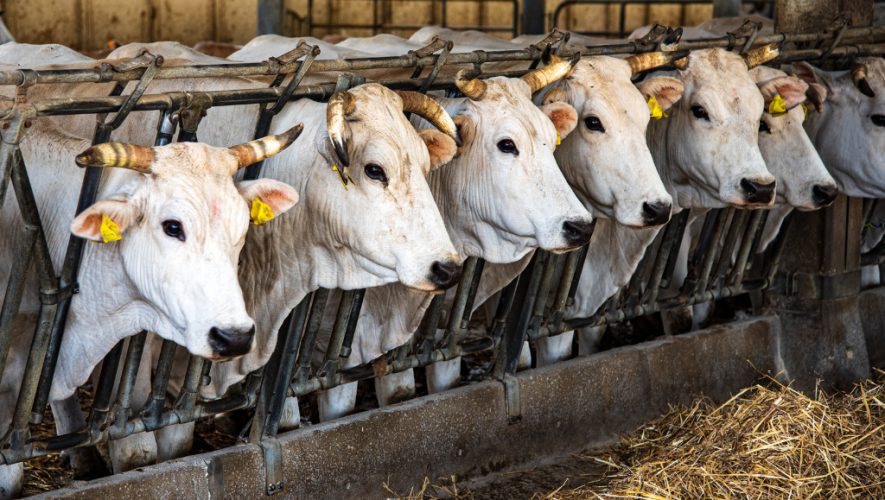Pro-vegan documentaries are everywhere. Netflix alone features Seaspiracy, Cowspiracy, You Are What You Eat, the Gamechangers, and more. These documentaries offer a variety of perspectives on the benefits of veganism, emphasizing its health and sustainability benefits. Paired with an overwhelming number of studies, these documentaries might lead Americans to believe that veganism is the best diet for the well-being of both themselves and the planet.
While to many people veganism appears to be a possible cure to the United States’ health and climate problems, one important factor is often overlooked: this would not be the case if the current American food system weren’t so deeply flawed. Our current food system makes a sustainable and healthy diet both inaccessible and expensive, and few are educated on its flaws. Veganism is not the best alternative, but it’s currently the only one because of a broken food system. In order to remedy this system, we must make the shift towards local farming and educate Americans on the foods they are consuming.
The Problem With the Standard American Diet
It’s undeniable that meat consumption is a primary driver of climate change. 14.5 percent of human-caused greenhouse gas emissions can be attributed to livestock farming, which releases large amounts of carbon dioxide, methane, and nitrous oxide into the atmosphere. Additionally, the average American consumes approximately 224.6 pounds of meat each year, triple the world average of 75.2 pounds. Given the incredibly high amount of meat consumption in the United States, it is impossible to deny the American connection to global greenhouse gas emissions.
In large amounts, animal products can also be unhealthy. Most European countries suggest consuming two servings of red meat and two servings of white meat a week to promote a healthy lifestyle. In contrast, the USDA recommends that Americans eat two to three servings of meat per day. While most Americans are trusting of the USDA, the reality of such a high recommended meat consumption dates back to the 1950s and 1960s, when the United States was attempting to grow in power and population. At this time, the health implications of high meat consumption had not been thoroughly studied, and meat was associated with high protein. This led federal organizations to promote its consumption under the assumption that it would promote population growth.
While protein is vital to human health, animal product consumption also has irrefutable downsides. There is a clear link between high consumption of red and processed meats with cancer, diabetes, and heart disease. Processed meats in particular, contain added nitrates and nitrites that can cause cancer. Processed meats are also high in sodium and other additives, which can lead to high blood pressure and heart problems.
What is even more concerning to American health, however, is the use of antibiotics and hormones in meat. To keep up with the demand in the United States, meat producers keep large amounts of animals in close proximity to each other, pumping them with hormones to ensure that they can grow muscle, despite not having space to exercise. In order to ensure that disease doesn’t spread among these animals, they are also pumped with antibiotics. These hormones and antibiotics are linked to an increase in prostate and breast cancers, early menstruation in girls, and rapid weight gain. The overuse of antibiotics can also lead to “superbugs” in animals, which can cause serious illness in humans.
Before we consume animal meat, we must look at what the animals themselves are consuming. Instead of nutrient-dense greens and grains that they would consume in the wild or on ethical farms, these animals eat foods that in no way align with their dietary needs. For example, the diet of a factory-farmed cow consists of corn and soy grains, which not only lacks nutrients, but takes large amounts of chemical fertilizer and oil to produce.
Grass-fed beef, on the other hand, contains double the amount of Vitamin E and Omega-3 acids, which offer a variety of health benefits, such as promoting heart and brain health. However, meat is not the only animal product that can cause health problems. Farmed fish can be extremely high in mercury, which has high levels of bacteria and can be harmful to the nervous system over time. Additionally, dairy products with high fat contents can lead to cardiovascular disease. Ultimately, if animal products were consumed sparingly and didn’t contain antibiotics and hormones, many of these health problems would not exist.
Alternative Solutions to Veganism
To avoid the negative health and environmental implications of the American food system, many have turned to veganism. Veganism has been proven to promote weight loss, decrease risks of heart disease, lower risks of certain types of cancers, and manage diabetes. Nonetheless, this diet can also eliminate key macronutrients and micronutrients of many diets. Vitamin B12, for example, plays an essential part in red blood cell production, but is found most commonly in meat. Vegans can also struggle with protein intake and eating enough calories to fuel their bodies.
Veganism is far from perfect, but it’s the only alternative to a damaged food system. Americans wouldn’t need to turn to a diet associated with vitamin and calorie deficiency if it wasn’t the lesser of two evils.
Knowing the negative health habits associated with animal product consumption in the United States, it is also important to understand positive health habits that lead to high quality of life and good health worldwide. Blue Zones are areas of the world with incredibly low rates of heart disease and cancer, and relatively high life expectancies. The diets of people in these zones consist of large amounts of vegetables, legumes, whole grains, and nuts. Interestingly, while this aligns with the diets of many vegans, animal products are consumed in moderation in these areas. That being said, Blue Zones like Sardinia, Italy, and Ikaria, Greece are isolated from much of the world and obtain their animal products through local farming—which is far more sustainable and healthy than American meat consumption.
While veganism eliminates many of the health concerns that many Americans face, it does not eliminate all of them. The standard American diet contains a large amount of processed foods, which do not necessarily contain animal products. Ultra-processed foods make up about 60 percent of the average American diet, and contain additives such as flavor enhancers, stabilizers, and preservatives. High consumption of these processed foods can be linked to obesity, hypertension, and breast and colorectal cancers. These diets are also nutrient sparse, as only one in ten Americans eat enough fruits and vegetables.
Moreover, the production of processed foods also has many negative environmental impacts. Processed food production has significantly impaired biodiversity in many areas, as the production of corn, oil, seeds, and soy take priority over the cultivation of the land’s natural crops. Processed foods also require the extra step of being developed in a large factory and shipped long distances, which adds to their carbon footprint.
In a perfect world, the American diet would be nutrient dense, locally sourced, and low in animal products. Unfortunately, these ideals are unrealistic because of the American food system as it stands. The normalized mass production of animal products makes it virtually impossible to trace where these products come from and how the animal was raised, and sourcing these products from local farms is both inaccessible and expensive. A diet rich in unprocessed foods and nutrients is also inaccessible and expensive, and this is exacerbated by the concept of food deserts. 18 percent of Americans live in these food deserts, which occur when there is limited or no access to a grocery store in a certain geographic region, and residents are forced to rely on fast food and processed foods to survive.
In marginalized or low-income communities, people do not have cars or access to reliable public transportation, and will likely buy less from supermarkets even if they have access. Beyond food deserts, processed foods are cheaper and last longer, which makes them more affordable. This means that a healthy and sustainable diet is only really a tangible concept for the American elite.
Countries outside of the US do not face the same food system challenges, with diets consisting of more nutrients, less meat, and less processed foods. In many European countries, there are stricter regulations on what can be sold and where it can be sold from. For example, in the European Union, while food is not necessarily sourced locally, many of the preservatives and chemicals used in the American diet are banned. The Federal Drug Administration (FDA) takes a more hands-off approach to testing ingredients than the European Food Safety Authority, as the FDA tends to allow ingredients unless proven harmful, whereas the EFSA requires any additives to be proven safe before being introduced into the market.
There are also initiatives within the European Union to promote diets that are more sustainable and include less animal products. Culturally speaking, global cuisines are often far healthier than what Americans consume. This is arguably due to the fact that the standard American diet was developed as a means of increasing calorie and protein consumption for population gain, while many global cuisines were developed organically through years of utilizing their resources and farming locally.
Solutions to the Standard American Diet
Veganism offers the best alternative to the standard American diet as we know it right now, but it is not the best option. Animal products are excellent sources of protein in moderation, and when paired with whole foods and fresh produce, are part of an optimal and sustainable diet. However, our current American food system makes this diet unattainable. Instead of selling these products from factory farms, American meat sellers must turn to local and ethical farms, which are undoubtedly more expensive. Though costly, this will result in a decrease in the consumption of animal products amongst Americans and an increase in overall health and sustainability.
Unfortunately, promoting local farms and rejecting factory farms has little legislative ground due to the fact that it would threaten the profitability of the meat industry and disrupt consumer lifestyles. This means that it’s up to Americans to make this change for themselves. To do so, young Americans need a complete, amplified health education.
Current national health standards are extremely vague, stating that schools should promote “the adoption and maintenance of specific health-enhancing behaviors.” Language like this needs to be replaced with specific policy on nutrition education in schools. Additionally, while many health programs mention the importance of a balanced diet in some form, health education should reinforce the importance of a sustainable diet. Educating consumers on the health impacts of their consumption is key to creating healthier norms amongst Americans—and therefore to promoting the transition from factory farming to local farming. A comprehensive health education would also promote the consumption of fruits, vegetables, and whole foods, and highlight the negative impacts of processed foods.
An overhaul of the way Americans think about and consume food is absolutely necessary. The American food system is killing people slowly, and it is bound to kill more indirectly through its contribution to the climate crisis. Currently, veganism is the best solution to this problem, but the reality is that veganism is only the best solution because of the American food system. An optimal food system should rely on local farming and whole foods whilst incorporating animal products in moderation, as proven by Blue Zones worldwide. The shift towards local farming and a society less centered around animal products will require time and education, but until then, Americans must learn to become conscious of their consumption and how it affects themselves and the world around them.


